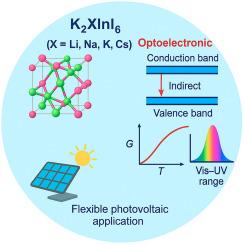Structural and multifunctional properties of elpasolite-type K2XInI6 (X = Li, Na, K and Cs) compounds for photovoltaic applications
IF 3.9
Q3 PHYSICS, CONDENSED MATTER
引用次数: 0
Abstract
The present research work investigates the optoelectronic, elastic, structural, and mechanical properties of elpasolite-type family related K2XInI6 (X = Li, Na, K and Cs) compounds by using GGA (Generalized gradient approximation) and PBE (Perdew-Burke-Ernzerhof) approach. The estimated band gaps of all the compounds are indirect in GGA-PBE approach ranging 0.567–1.634 eV and the calculated band gaps in HSE06 approach are direct in energy ranging of 1.765–2.820 eV, which indicate that they are semiconductors and ideal for energy efficient applications. Thermodynamic properties of the compounds are explored by utilizing density functional perturbation theory (DFPT) approach and powder XRD analysis is performed by using reflex code, the XRD patterns exhibit distinct peaks of varying intensities between 2θ = 5° to 45°. The Debye temperature increases rapidly as the applied temperature (K) increases, entropy, enthalpy and free energy also vary with applied temperature while heat capacity (CV) rises with temperature reaching the Dulong-Petit limit about 200 K. The optical features include refractive index (2–3), optical conductivity (5 fs−1), absorption coefficient (105cm−1) and dielectric function (5–6) have all shown high values in visible and UV range. The mechanical characteristics support the ductile nature of compounds and indicate that they are ideal for flexible photovoltaic applications. This study gives critical information regarding the compounds, demonstrating that they are appropriate for next-generation solar technologies.

光伏用elpasolite型K2XInI6 (X = Li, Na, K和Cs)化合物的结构和多功能性质
本研究采用GGA(广义梯度近似)和PBE (perdu - burke - ernzerhof)方法研究了elpasolite类型家族相关K2XInI6 (X = Li, Na, K和Cs)化合物的光电、弹性、结构和力学性能。所有化合物在GGA-PBE法中估计的带隙在0.567 ~ 1.634 eV之间是间接的,在HSE06法中计算的带隙在1.765 ~ 2.820 eV之间是直接的,这表明它们是半导体,是节能应用的理想选择。利用密度泛函微扰(DFPT)方法研究了化合物的热力学性质,并用反射码进行了粉末XRD分析,XRD谱图在2θ = 5°~ 45°范围内表现出不同强度的明显峰。德拜温度随温度的升高而迅速升高,熵、焓和自由能也随温度的升高而变化,热容随温度的升高而升高,达到200 K左右的Dulong-Petit极限。光学特性包括折射率(2-3)、光导率(5 fs−1)、吸收系数(105cm−1)和介电函数(5 - 6)在可见光和紫外范围内均显示出较高的值。机械特性支持化合物的延展性,并表明它们是柔性光伏应用的理想选择。这项研究提供了有关这些化合物的关键信息,证明它们适用于下一代太阳能技术。
本文章由计算机程序翻译,如有差异,请以英文原文为准。
求助全文
约1分钟内获得全文
求助全文
来源期刊

Computational Condensed Matter
PHYSICS, CONDENSED MATTER-
CiteScore
3.70
自引率
9.50%
发文量
134
审稿时长
39 days
 求助内容:
求助内容: 应助结果提醒方式:
应助结果提醒方式:


